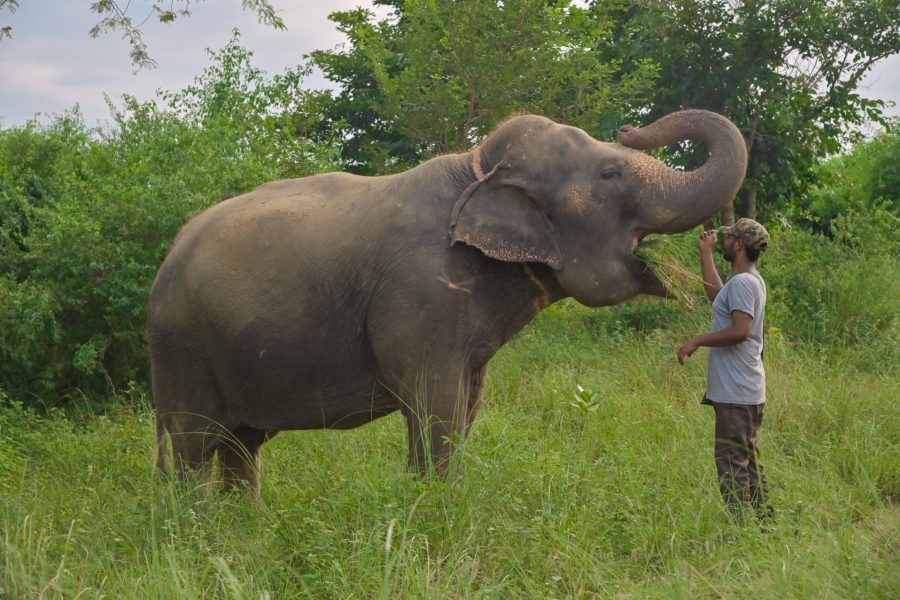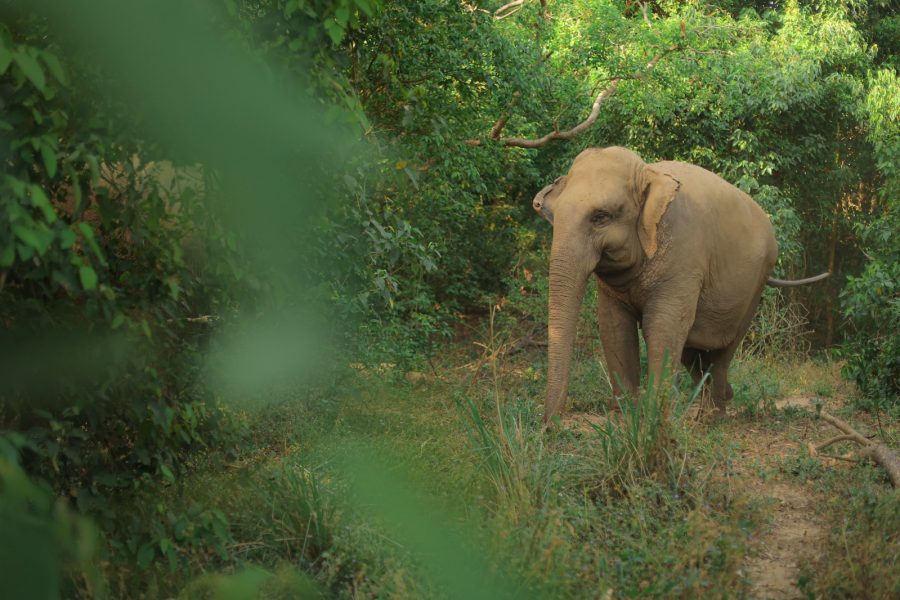Consider this: An employee reaches their workplace on time every day, completes each task assigned, and meets all targets. For such excellent performance, the staff member is rewarded with a gift card at the end of every month, which motivates the employee to repeat this behaviour in the upcoming months as well. This practice of encouraging an individual to take the desired steps to obtain a much-wanted result is called operant conditioning — a theory that was arrived at by renowned psychologist B.F. Skinner. Including the promise of a reward after tasks are completed successfully is known as positive reinforcement. Among human beings, the provision of perks by a company stimulates employees to accomplish their goals. Drawing from its valuable impact, this technique has also been adapted by wildlife specialists and conservationists to provide aid to animals that reside in sanctuaries for life-long care.
At Wildlife SOS, our expert staff at Elephant Hospital Campus (EHC) and Elephant Conservation and Care Centre (ECCC) follow target training, a method that incorporates operant conditioning with positive reinforcements so that our rescued resident elephants are able to cooperate during their medical treatments and checkups. We will understand this process in depth as we proceed.
What is Target Training?
Target training is carried out for the welfare of rehabilitated animals to help them imbibe specific behaviours. It is a humane approach and cancels out the need to sedate the animal in order to conduct any medical examination or treatment. It also plays a huge role in eliminating stress for the animal, so that the animal can cooperate with ease. In the process of target training, the animal is encouraged to present the required body part in response to a tool called target. As soon as the animal completes this action, it is rewarded with edible treats. Treats act as a positive reinforcement, and form a crucial aspect of target training. They help to instil a desired pattern of behaviour among the animals whenever they interact with the professional teams that are managing their upkeep.
How is Target Training carried out with Elephants at Wildlife SOS?
To help rescued elephants under our care understand certain specific cues, our skilled team uses a target — a flexible pole that has a soft and spongy ball at the end of it — to gently guide them. The target is lightly touched on the area that needs to be presented. This exercise of performing a desired behaviour aims to prepare elephants to calmly cooperate during their medical treatments and regular check-ups.
Wildlife SOS conducts repetitive sessions on target training to enable the elephant to understand what exactly is supposed to be done. Positive reinforcements of treats like vegetables, fruits, sugarcanes, peanuts, roasted grams, and dates are always kept ready to be rewarded to the pachyderms. These treats greatly motivate the elephant to actively respond to prompts from the target. Our team at Wildlife SOS also adds kind gestures and verbal praise as positive reinforcements during the entire process. As elephants are highly cognitive mammals, their supreme intelligence leads them to associate the act of touching the target with the promise of receiving a reward.
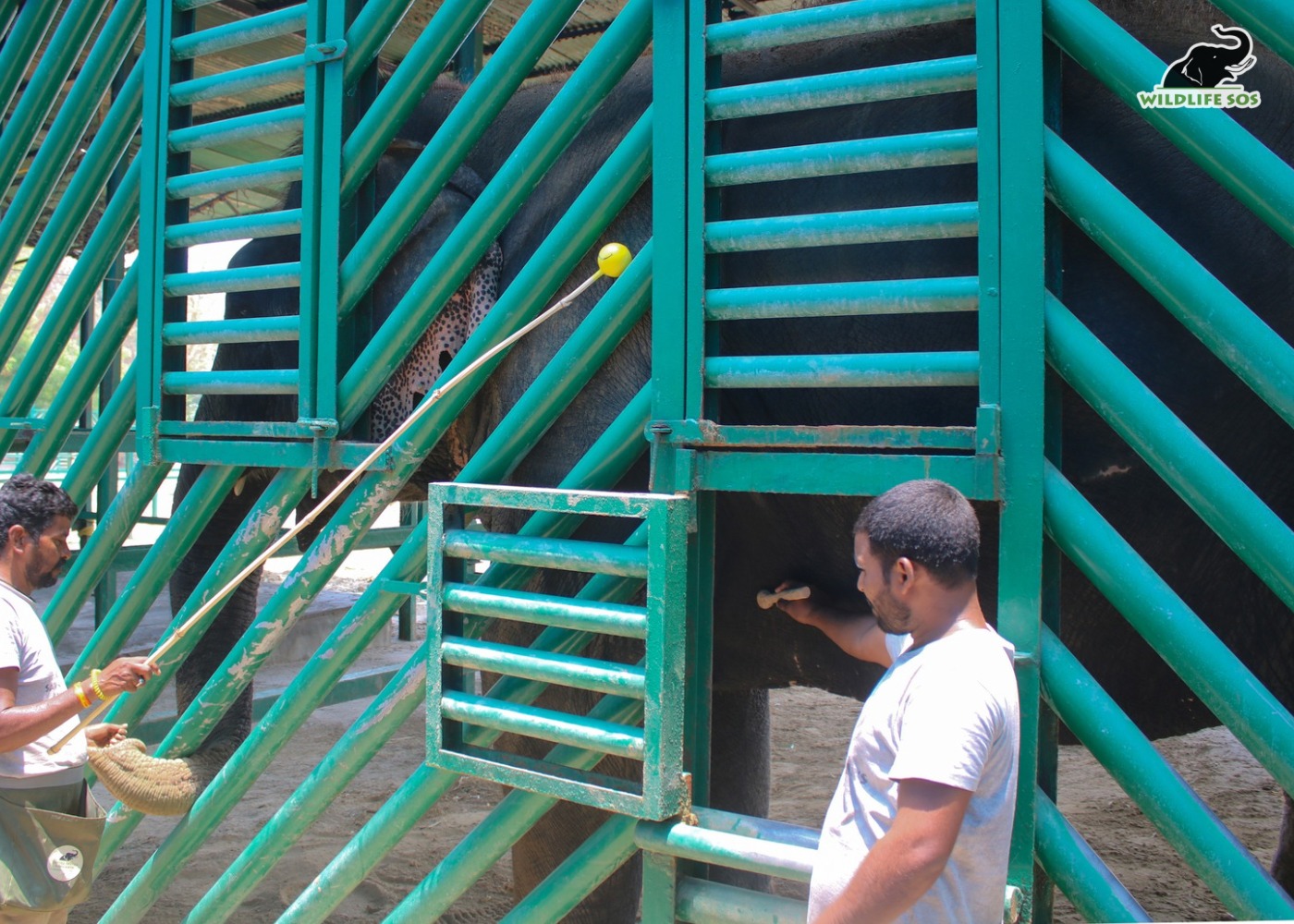
At Wildlife SOS, only an animal behaviourist and mahouts (caregivers) are allowed to conduct these behaviour shaping sessions for elephants. Establishing a strong bond of trust with the elephant is the first step that the caregiver takes when he initiates target training with the pachyderm. This takes time, skill, patience and a thorough understanding of the concerned elephant’s health, physical condition, temperament and behaviour. Depending on these factors, the target training sessions can last from weeks and months to years, during which the response and reaction of the elephants are noted closely. At EHC and ECCC, all elephants undergo target training twice every day, once in the morning and the next in the evening.
For the target training session, caregivers use a common method called “clicker training” that makes use of a small gadget known as a clicker. When the clicker is pressed, it makes a distinctive sound to let the elephant know that their response to a prompt was appropriate. The elephant then gets treats along with vocal appreciation like “good boy” or “good girl”. The elephant soon familiarises itself with the pattern that the right response to the cue would be followed by a ‘click’ and a reward.
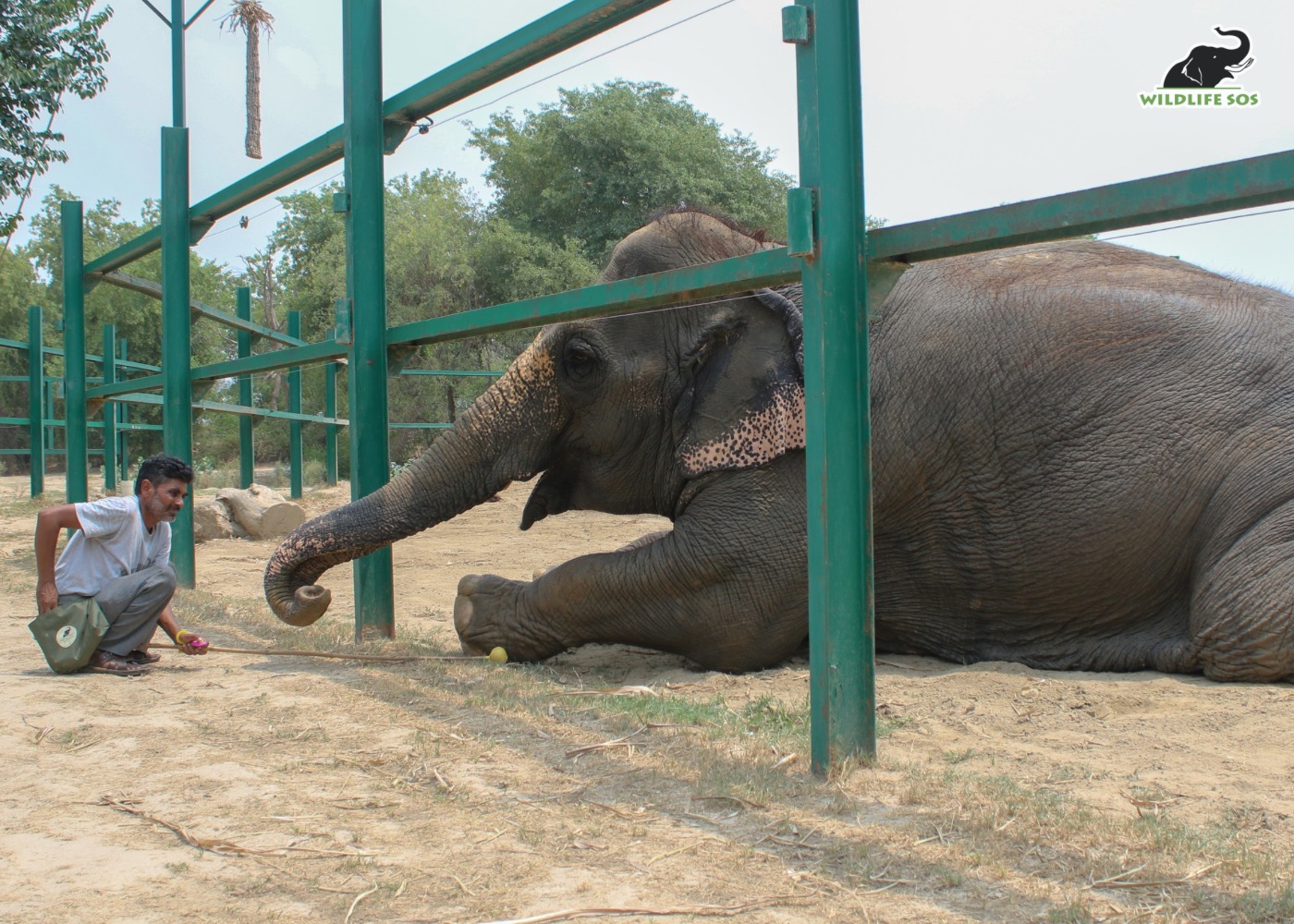
Emma, one of the resident elephants at the EHC, is lightly touched on the head with the tip of the target before the caregiver says “target” to begin the session. When she lets her head make voluntary contact with the target, he presses the clicker and gives her a treat. Emma is now highly alert of the ‘click’ sound, and shows a readiness to take the treat as soon as she hears it. For elephants like Chanchal, Laxmi and Phoolkali, soft prompts to flap their ears, open their mouth or lift their leg result in positive responses during target training sessions.
While the above method works for elephants who have sight, our centres also house elephants that are visually impaired. For a blind elephant, verbal cues need to be used during these training sessions to gather a positive response for regular checkups. For instance, in case the ear of a sightless elephant needs to be checked, the word “jhuk” is uttered kindly by the caregiver. The tall pachyderm then bends its head low enough to help the veterinarian examine the ear properly. Abundant rewards are swiftly given to the elephant to joyfully munch on.
The Protected Contact Wall
A Protected Contact (PC) wall is a structure designed to facilitate safe interactions between caregivers and elephants. As the name suggests, the wall serves as a form of protection for both the parties during target training sessions. However, the grills on the wall do not obstruct the view (or the bond) between the caregiving staff and the elephant. It enables the staff and the pachyderm to harmlessly repeat the same target training exercises for months on end.
Every elephant enclosure at Wildlife SOS centres consists of one PC wall, where the elephant reaches after being enticed by delicious treats. These PC walls stand over 10 feet tall and are made of stainless iron. It features openings or windows which provide access points for caregivers to conduct various training exercises. There are three windows in all, one where the foot can be placed and examined from, and two where the elephant can bring its ears to. These openings are strategically located to minimise risk to both the elephant and the caregiver.
Emma, Laxmi, Chanchal and Phoolkali are extremely cooperative elephants that have been responding well during the target training sessions. Elephants like Mac and Ramu, on the other hand, are highly impatient by nature, and therefore, their dedicated caregivers need to display immense patience from their end during the sessions! PC walls are also beneficial for medical care of bull elephants experiencing musth, a natural periodic phase characterised by heightened testosterone levels. Through the grilled wall, their physical ailments can be addressed in a secure manner.
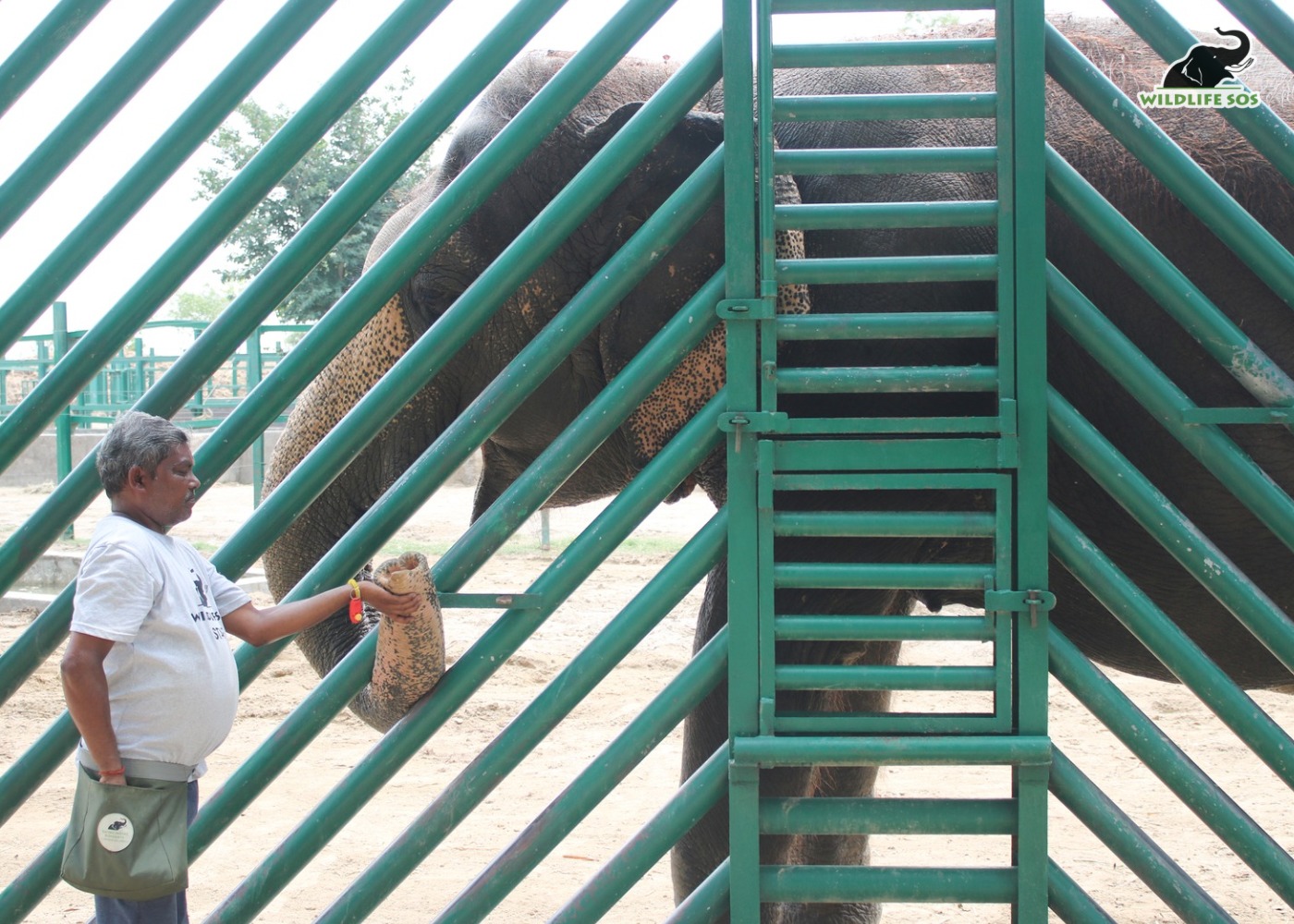
Target Training for Resident Elephants
Rescued elephants were once subjected to cruelty that involved constant yelling and beating to elicit required behaviour. Under the long-term care of Wildlife SOS, these elephants are communicated with in a humane way, using pleasant words and gestures. In his early days of rescue, Bhola would close his eyes during target training sessions before any cue or prompt was given because his brutal captivity had conditioned him to expect smacks and hits. Slowly, the bull elephant realised that this unkind chapter was now his past.
Our team has noted that initial sessions with elephants that arrived from a traumatic life last for 10 to 15 minutes each. Over time, the elephants gain confidence in the process and become more comfortable. The sessions are then divided into 3 parts that last for 3 to 6 minutes each, and have a gap of one minute between them.
Target training prepares elephants to remain comfortable when actual treatments are being performed by the medical team. In cases where serious wounds need extended treatment, the staff comforts resident elephants with a steady supply of treats so that they feel stress-free during the examination and treatment processes.
The veterinarians at Wildlife SOS check the overall health of elephants by examining the parts of their body that are listed below. The large mammals are able to present them with ease after undergoing persistent target training sessions:
- Head: The initial target training sessions for an elephant focus on directing the pachyderm’s attention to its head. When the elephant makes head contact with the target, it is rewarded to let it know that the response was good. Perfect presentation of the head lays a foundation for elephants to understand the cues involved in presenting other parts of the body.
- Trunk: Target training encourages the elephant to put forward its trunk so that if and when required, wash samples from the elephant’s distil respiratory tract can be used for disease screening.
- Side Body: Access to the left side of an elephant’s body is required for cardiothoracic auscultation, allowing the veterinarians to detect sound and rhythm of their heart. By turning on the side, the elephant allows the deliverance of intramuscular injections on shoulder or hip, inspection of any wounds or injuries, and application of dressing on them if needed.
- Teeth: These are examined to assess the condition of the molars. Elephants undergo 6 sets of tooth eruptions throughout their lifetime, and it’s essential to monitor the condition of each eruption.
- Front and Back Feet: For corrective toenail trimming and to identify any potential foot problems, cues to present feet are provided. The veterinarians also conduct X-ray of a foot in different angles if required.
- Ears: Require examination for any signs of concern. Ears need to be shown by the elephant for blood collection, and pulse rate can be monitored from aural arteries.
- Eyes: Ultrasonographic examination and administering any eye drops if required can be done when the medical team is able to access the eyes.
- Tail: The tail cue allows the team to conduct blood pressure measurement and the examination of the rectal region.
Along with the above, the elephants are also directed to assume postures that can help our medical team inspect and prescribe treatments:
- Sitting Position: Sitting down position assures the staff of the flexibility of the elephant’s joints, particularly in the hips, knees, and ankles.
- Bending Downwards: A dorsal view inspection can be made when the elephant bends its forelegs (as displayed in the image below). This way, the medical staff can check if any infection has taken place on their back and body after dust baths.
- Laying Position: In some cases, elephants need to be closely examined, especially when veterinarians need to observe areas that may be difficult to access through the PC wall. The laying position of an elephant allows the team to carefully assess physical issues and provide suitable applications for it.
The expertise with which target training is being conducted for elephants at Wildlife SOS has proven to be successful in medically treating those that suffer from chronic physical maladies due to former neglected captivity. Not just elephants, but the rescued sloth bears under Wildlife SOS’s long-term care also receive target training by our expert staff so that required medical treatment is performed safely. To witness these once-traumatised animals now voluntarily engaging in behaviours that are helping them heal their physical and mental scars is truly overwhelming. Through patient and compassionate methods, our professional teams have made sure to establish trust in the bears and elephants under their care. We urge you to accompany Wildlife SOS in its mission to stand against wildlife exploitation and work towards animal welfare by making a donation here.


